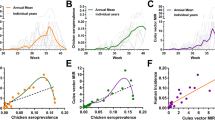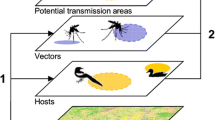Abstract
West Nile virus (WNV; family Flaviviridae) causes a disease in humans that may develop into a deadly neuroinvasive disease. In North America, several peridomestic bird species can develop sufficient viremia to infect blood-feeding mosquito vectors without succumbing to the virus. Mosquito species from the genus Culex, Aedes and Ochlerotatus display variable host preferences, ranging between birds and mammals, including humans, and may bridge transmission among avian hosts and contribute to spill-over transmission to humans. In this study, we aimed to test the effect of density of three mosquito species and two avian species on WNV mosquito infection rates and investigated the link between spatiotemporal clusters of high mosquito infection rates and clusters of human WNV cases. We based our study around the city of Ottawa, Canada, between the year 2007 and 2014. We found a large effect size of density of two mosquito species on mosquito infection rates. We also found spatiotemporal overlap between a cluster of high mosquito infection rates and a cluster of human WNV cases. Our study is innovative because it suggests a role of avian and mosquito densities on mosquito infection rates and, in turn, on hotspots of human WNV cases.


Similar content being viewed by others
References
Andreadis TG (2012) The contribution of Culex pipiens complex mosquitoes to transmission and persistence of West Nile Virus in North America. Journal of the American Mosquito Control Association 28:137–151. https://doi.org/10.2987/8756-971x-28.4s.137
Apperson CS, Hassan HK, Harrison BA, Savage HM, Aspen SE, Farajollahi A, Crans W, Daniels TJ, Falco RC, Benedict M, Anderson M, McMillen L, Unnasch TR (2004) Host feeding patterns of established and potential mosquito vectors of West Nile Virus in the eastern United States. Vector-Borne Zoonotic Diseases 4:71–82. https://doi.org/10.1089/153036604773083013
Artsob H, Lindsay R, Drebot M (2006) Biodiversity-related aspects of West Nile Virus and its cycle in nature. Biodiversity 7:18–23. https://doi.org/10.1080/14888386.2006.9712790
Barton K (2013) MuMIn: Multi-Model Inference. Krakow: Institute of Nature Conservation
Burkett-Cadena ND, Graham SP, Hassan HK, Guyer C, Eubanks MD, Katholi CR, Unnasch TR (2008) Blood feeding patterns of potential arbovirus vectors of the genus Culex targeting ectothermic hosts. American Society of Tropical Medicine and Hygiene 79:809–815
Chancey C, Grinev A, Volkova E, Rios M (2015) The global ecology and epidemiology of West Nile Virus. BioMed Research International 2015:1–20. https://doi.org/10.1155/2015/376230
Chaves A, Sotomayor-Bonilla J, Monge O, Ramírez A, Galindo F, Sarmiento-Silva RE, Gutiérrez-Espeleta GA, Suzán G (2016) West Nile Virus in resident birds from Yucatan, Mexico. Journal of Wildlife Diseases 52:159–163. https://doi.org/10.7589/2015-02-046
Darsie R, Ward R (2005) Identification and Geographical Distribution of the Mosquitoes of North America, North of Mexico, 2nd ed., Gainsville: University Press of Florida
Diaz LA, Quaglia AI, Konigheim BS, Boris AS, Aguilar JJ, Komar N, Contigiani MS (2016) Activity patterns of St. Louis Encephalitis and West Nile Viruses in free ranging birds during a human encephalitis outbreak in Argentina. PLOS ONE 11:e0161871. https://doi.org/10.1371/journal.pone.0161871
Drebot MA, Lindsay R, Barker IK, Buck PA, Fearon M, Hunter F, Sockett P, Artsob H (2003) West Nile virus surveillance and diagnostics: a Canadian perspective. Canadian Journal of Infectious Diseases and Medical Microbiology 14:105–114
Eisen RJ, Eisen L (2008) Spatial modeling of human risk of exposure to vector-borne pathogens based on epidemiological versus arthropod vector data. Journal of Medical Entomology 45:181–192. https://doi.org/10.1603/0022-2585(2008)45%5b181:smohro%5d2.0.co;2
Environment and Natural Resources Canada (2018) Past Weather and Climate, Historical Data. Ottawa, ON, Canada
Epstein PR, Defilippo C (2001) West Nile Virus and drought. Global Change Human Health 2:105–107. https://doi.org/10.1023/A:1015089901425
Farajollahi A, Fonseca DM, Kramer LD, Marm Kilpatrick A (2011) “Bird biting” mosquitoes and human disease: A review of the role of Culex pipiens complex mosquitoes in epidemiology. Infection, Genetics and Evolution 11:1577–1585. https://doi.org/10.1016/j.meegid.2011.08.013
Foppa IM, Beard RH, Mendenhall IH (2011) The impact of West Nile virus on the abundance of selected North American birds. BMC Veterinary Research 7:43. https://doi.org/10.1186/1746-6148-7-43
Ganser C, Wisely SM (2013) Patterns of spatio-temporal distribution, abundance, and diversity in a mosquito community from the eastern Smoky Hills of Kansas. Journal of Vector Ecology 38:229–236. https://doi.org/10.1111/j.1948-7134.2013.12035.x
Giordano BV, Kaur S, Hunter FF (2017) West Nile Virus in Ontario, Canada: a twelve-year analysis of human case prevalence, mosquito surveillance, and climate data. PLOS ONE 12:e0183568. https://doi.org/10.1371/journal.pone.0183568
Greenberg JA, Lujan DA, DiMenna MA, Wearing HJ, Hofkin BV (2013) Identification of blood meal sources in Aedes vexans and Culex quinquefasciatus in Bernalillo County, New Mexico. Journal of Insect Science 13:1–12. https://doi.org/10.1673/031.013.7501
Gubler DJ (2007) The continuing spread of West Nile Virus in the western hemisphere. Clinical Infectious Diseases 45:1039–1046. https://doi.org/10.1086/521911
Hamer GL, Kitron UD, Brawn JD, Loss SR, Ruiz MO, Goldberg TL, Walker ED (2008) Culex pipiens (Diptera: Culicidae): a bridge vector of West Nile Virus to humans. Journal of Medical Entomology 45:125–128. https://doi.org/10.1093/jmedent/45.1.125
Hamer GL, Kitron UD, Goldberg TL, Brawn JD, Loss SR, Ruiz MO, Hayes DB, Walker ED (2009) Host selection by Culex pipiens mosquitoes and West Nile Virus amplification. American Society of Tropical Medicine and Hygiene 80:268–278
Hughes TP, Paul JH, Smithburn KC, Burke AW (1940) A neurotropic virus isolated from the blood of a native of Uganda. American Society of Tropical Medicine and Hygiene s1-20:471–492. https://doi.org/10.4269/ajtmh.1940.s1-20.471
Johnson PCD (2014) Extension of Nakagawa & Schielzeth’s R 2GLMM to random slopes models. Methods in Ecology and Evolution 5:944–946. https://doi.org/10.1111/2041-210x.12225
Kaufman MG, Fonseca DM (2014) Invasion biology of Aedes japonicus japonicus (Diptera: Culicidae). Annual Review of Entomology 59:31–49. https://doi.org/10.1146/annurev-ento-011613-162012
Kilpatrick AM, Daszak P, Jones MJ, Marra PP, Kramer LD (2006) Host heterogeneity dominates West Nile Virus transmission. Proceedings of Royal Society B: Biological Sciences 273:2327–2333. https://doi.org/10.1098/rspb.2006.3575
Kilpatrick AM, LaDeau SL, Marra PP (2007) Ecology of West Nile Virus transmission and its impact on bird in the western hemisphere. The Auk 124:1121. https://doi.org/10.1642/0004-8038(2007)124%5b1121:eownvt%5d2.0.co;2
Komar O, Robbins MB, Klenk K, Blitvich BJ, Marlenee NL, Burkhalter KL, Gubler DJ, Gonzálvez G, Peña CJ, Peterson AT, Komar N (2003) West Nile Virus transmission in resident birds, Dominican Republic. Emerging Infectious Diseases Dis 9:1299–1302. https://doi.org/10.3201/eid0910.030222
Kulldorff M (1997) A spatial scan statistic. Communications in Statistics Theory and Methods 26:1481–1496. https://doi.org/10.1080/03610929708831995
Lanciotti RS, Kerst AJ, Nasci RS, Godsey MS, Mitchell CJ, Savage HM, Komar N, Panella NA, Allen BC, Volpe KE, Davis BS, Roehrig JT (2000) Rapid detection of West Nile Virus from human clinical specimens, field-collected mosquitoes, and avian samples by a TaqMan reverse transcriptase-PCR assay. Journal of Clinical Microbiology 38:4066–4071
Levi ME (2013) West Nile Virus Infection in the Immunocompromised Patient. Current Infectious Disease Reports 15:478–485. https://doi.org/10.1007/s11908-013-0367-8
Levine RS, Hedeen DL, Hedeen MW, Hamer GL, Mead DG, Kitron UD (2017) Avian species diversity and transmission of West Nile Virus in Atlanta, Georgia. Parasit Vectors 10. https://doi.org/10.1186/s13071-017-1999-6
Mallya S, Sander B, Roy-Gagnon M-H, Taljaard M, Jolly A, Kulkarni MA (2018) Factors associated with human West Nile virus infection in Ontario: a generalized linear mixed modelling approach. BMC Infectious Diseases 18:1–9. https://doi.org/10.1186/s12879-018-3052-6
Marini G, Rosá R, Pugliese A, Heesterbeek H (2017) Exploring vector-borne infection ecology in multi-host communities: a case study of West Nile virus. Journal of Theoretical Biology 415:58–69. https://doi.org/10.1016/j.jtbi.2016.12.009
Molaei G, Andreadis TG (2006) Identification of avian- and mammalian-derived bloodmeals in Aedes vexans and Culiseta melanura (Diptera: Culicidae) and its implication for West Nile Virus transmission in Connecticut, USA. Journal of Medical Entomology 43:1088–1093. https://doi.org/10.1603/0022-2585(2006)43%5b1088:ioaamb%5d2.0.co;2
Morales-Betoulle ME, Komar N, Panella NA, Alvarez D, López MR, Betoulle J-L, Sosa SM, Müller ML, Kilpatrick AM, Lanciotti RS, Johnson BW, Powers AM, Cordón-Rosales C, Arbovirus Ecology Work Group (2013) West Nile virus ecology in a tropical ecosystem in Guatemala. American Society of Tropical Medicine and Hygiene 88:116–126. https://doi.org/10.4269/ajtmh.2012.12-0276
Ontario Ministry of Health and Long-Term Care (2017) Infectious disease protocol, Appendix B: provincial case definitions for reportable diseases: West Nile Virus illness. Toronto, ON, Canada
Ozdenerol E, Taff G, Akkus C (2013) Exploring the spatio-temporal dynamics of reservoir hosts, vectors, and human hosts of West Nile Virus: a review of the recent literature. International Journal of Environmental Research and Public Health 10:5399–5432. https://doi.org/10.3390/ijerph10115399
Public Health Ontario (2013) Guide for Public Health Units: Considerations for Adult Mosquito Control. Toronto: Queen’s Printer for Ontario
Public Health Ontario (2012) Vector-Borne Diseases: 2012 Summary Report. Toronto: Queen’s Printer for Ontario
Reisen WK (2013) Ecology of West Nile Virus in North America. Viruses 5:2079–2105. https://doi.org/10.3390/v5092079
Reisen WK, Fang Y, Martinez VM (2006) Effects of temperature on the transmission of West Nile Virus by Culex tarsalis (Diptera: Culicidae). Journal of Medical Entomology 43:309–317. https://doi.org/10.1093/jmedent/43.2.309
Reisen WK, Padgett K, Fang Y, Woods L, Foss L, Anderson J, Kramer V (2013) Chronic infections of West Nile Virus detected in California dead birds. Vector-Borne Zoonotic Diseases 13:401–405. https://doi.org/10.1089/vbz.2012.1097
Ruiz MO, Tedesco C, McTighe TJ, Austin C, Kitron U (2004) Environmental and social determinants of human risk during a West Nile Virus outbreak in the greater Chicago area, 2002. International Journal of Health Geographic 3:8. https://doi.org/10.1186/1476-072x-3-8
Shepard JJ, Andreadis TG, Thomas MC, Molaei G (2016) Host associations of mosquitoes at Eastern Equine Encephalitis Virus foci in Connecticut, USA. Parasit Vectors 9. https://doi.org/10.1186/s13071-016-1765-1
Smith KA, Campbell GD, Pearl DL, Jardine CM, Salgado-Bierman F, Nemeth NM (2018) A retrospective summary of raptor mortality in Ontario, Canada (1991–2014), including the effects of West Nile Virus. Journal of Wildlife Diseases 54:261–271. https://doi.org/10.7589/2017-07-157
Statistics Canada (2016) Health Profile. Ottawa, ON, Canada
Symonds MRE, Moussalli A (2011) A brief guide to model selection, multimodel inference and model averaging in behavioural ecology using Akaike’s Information Criterion. Behavioral Ecology and Sociobiology 65:13–21. https://doi.org/10.1007/s00265-010-1037-6
Thielman A, Hunter F (2007) A photographic key to the adult female mosquitoes (Diptera: Culicidae) of Canada. Canadian Journal of Arthropod Identification 4:1–116. https://doi.org/10.3752/cjai.2007.04
Trawinski PR, MacKay DS (2008) Meteorologically conditioned time-series predictions of West Nile Virus vector mosquitoes. Vector-Borne Zoonotic Diseases 8:505–522. https://doi.org/10.1089/vbz.2007.0202
TSentr gigieny i ėpidemiologii v Respublike Tatarstan (2013) Likhoradka Zapadnogo Nila. Kazanskiĭ gosudarstvennyĭ meditsinskiĭ, Kazan, Russia
van der Meulen KM, Pensaert MB, Nauwynck HJ (2005) West Nile Virus in the vertebrate world. Archives of Virology 150:637–657. https://doi.org/10.1007/s00705-004-0463-z
VanDalen KK, Hall JS, Clark L, McLean RG, Smeraski C (2013) West Nile Virus infection in American robins: new insights on dose response. PLoS ONE 8:e68537. https://doi.org/10.1371/journal.pone.0068537
Winters AM, Bolling BG, Beaty BJ, Blair CD, Eisen RJ, Meyer AM, Pape WJ, Moore CG, Eisen L (2008) Combining mosquito vector and human disease data for improved assessment of spatial West Nile Virus disease risk. American Society of Tropical Medicine and Hygiene 78:654–665
Wood DM, Dang PT, Ellis RA (1979) The mosquitoes of Canada: Diptera, Culicidae. Hull, QC, Canada: Agriculture Canada
Yoo E-H, Chen D, Diao C, Russell C (2016) The effects of weather and environmental factors on West Nile Virus mosquito abundance in Greater Toronto Area. Earth Interaction 20:1–22. https://doi.org/10.1175/ei-d-15-0003.1
Acknowledgements
We thank Canadian Institutes of Health Research for funding of the project. We thank employees of GDG Environment for their mosquito abundance and WNV test data, volunteers of Ontario Bird Count for access to their spatially interpolated bird density data, employees of Ottawa Public Health for their human WNV case data, and employees of Environment and Natural Resources Canada for meteorological data. We thank Monir Taha for their useful comments on an earlier version of the manuscript. We thank all members from the INSIGHT lab for their suggestions and comments on the analyses and the initial draft of the manuscript.
Author information
Authors and Affiliations
Corresponding author
Electronic supplementary material
Below is the link to the electronic supplementary material.
Rights and permissions
About this article
Cite this article
Talbot, B., Caron-Lévesque, M., Ardis, M. et al. Linking Bird and Mosquito Data to Assess Spatiotemporal West Nile Virus Risk in Humans. EcoHealth 16, 70–81 (2019). https://doi.org/10.1007/s10393-019-01393-8
Received:
Revised:
Accepted:
Published:
Issue Date:
DOI: https://doi.org/10.1007/s10393-019-01393-8




